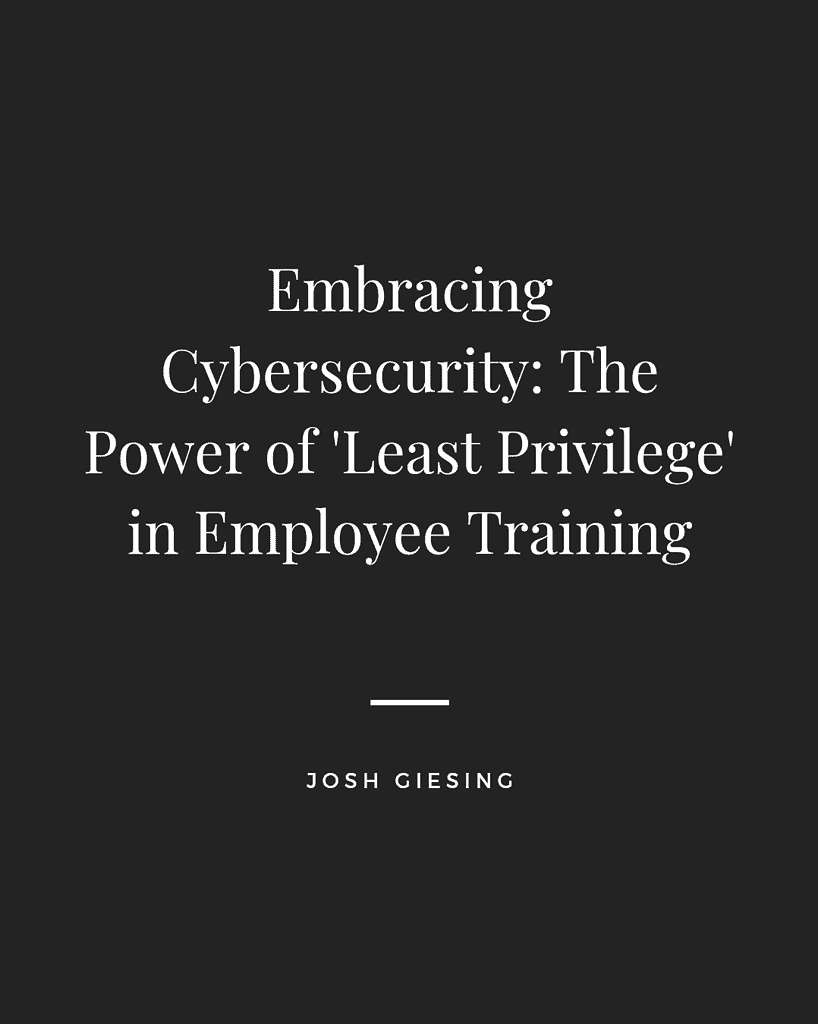I would consider using the principle of least privilege as one of the most important steps admins can take to protect their networks. My team and I consider the networks we work on as ‘our network.’ We put hard work into keeping the systems running and secure, but an often overlooked area is controlling system access. In the crazy and usually convoluted world of cybersecurity, the principle of least privilege (PoLP) stands out as a core security measure that can be overlooked frequently. Its premise is straightforward—individuals within an organization should only have access to the necessary information and resources for their job functions. But why is it crucial, and how does it intertwine with employee training? Let’s dive in.
Demystifying the Principle of Least Privilege
Least privilege isn’t merely a best practice — it’s a formidable shield, a defensive wall against unauthorized access, data breaches, and malware within any organization. By confining access, we limit the potential damage from compromised accounts or insider threats.
Consider this example from our archives: as Microsoft 365 (formerly Office 365) gained traction, we often encountered the hazardous practice of the business owner also acting as the administrator. Here’s why that creates a perfect storm:
- The Domino Effect: Compromise of the business owner’s account reverberates throughout the organization. Full admin control opens the floodgates to affecting other users within the tenant, often leading to the purchase of additional 365 licenses, even domains, to send malicious emails.
- Lack of Expertise: Business owners, typically untrained in effectively administering the tenant, may inadvertently break or delete data.
However, business owners should have full admin access, but it needs to be a separate account from their day-to-day account. The business owner should exercise restraint in using the admin account unless necessary. If we are working with a comanaged environment, then the local IT team will have the admin account instead of the business owner.

Employee Training: The Armor Against Cyber Threats
The strength of your cybersecurity system is only as strong as its weakest link – your personnel. Breaches are inevitable, but their impact can be mitigated with education. Comprehensive employee training fortifies the implementation of least privilege. Here’s how:
Awareness Breeds Compliance
Turn your staff from potential cybersecurity risks into vigilant gatekeepers by instilling a culture of best practices, like PoLP.
Role-Specific Training
Tailored training programs ensuring employees understand their access boundaries can foster respect towards data protection and demonstrate your commitment to security. Security training specific to their role will also greatly enhance your company’s security posture.
Continuous Learning
The digital threat landscape is a chameleon, constantly changing. Regular training updates help employees stay equipped against evolving threats, reinforcing the adherence to least privilege principles.
Simulated Cyber-Attack Exercises
Real-world simulations can assess the effectiveness of the PoLP adherence, identifying areas that require additional training. You will get the best results if you test your use and adapt accordingly.
The Payoff: Integrating Least Privilege with Employee Training
PoLP and employee training can be a gamechanger:
- Fortified Security Posture: A well-drilled workforce acts as your first line of defense, drastically reducing the risk of data breaches.
- Mitigated Insider Threats: Understanding the scope and limits of access minimizes the probability of intentional or accidental insider threats.
- Efficient IT Operations: Reduced access levels enable IT teams to manage user accounts more effectively and monitor unusual activities. It will greatly enhance security and stop unapproved software from being installed.
- Regulatory Compliance: Adherence to least privilege is often mandatory in regulatory frameworks, safeguarding sensitive data.
Final Thoughts
Adopting the principle of least privilege in employee training is more than a security measure – it’s an intelligent business strategy. It cultivates a security culture, shrinks the attack surface, and turns your employees into part of the solution. Businesses of all sizes should incorporate the least privilege in training programs isn’t just significant – it’s indispensable.
Investing in comprehensive training that integrates least privilege principles isn’t an expense but an investment in future security and organizational resilience. Knowledge isn’t just power in cybersecurity – it’s the strongest armor. Most MSP leaders grasp the importance of least privilege; it’s time for business owners and smaller IT teams to step up, own this risk, and mitigate it through the judicious application of least privilege. I know the pain in getting a small business owner to take advice, but as security threats continue to grow, we must remind the company that this is in their best interest.
